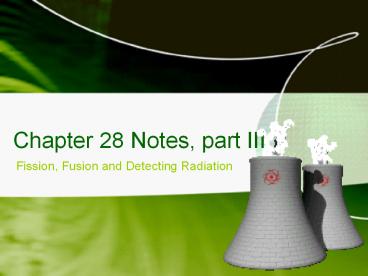Chapter 28 Notes, part III - PowerPoint PPT Presentation
1 / 10
Title:
Chapter 28 Notes, part III
Description:
Chapter 28 Notes, part III Fission, Fusion and Detecting Radiation Fission When bombarded with neutrons, some isotopes undergo fission. Rather than a or b decay, they ... – PowerPoint PPT presentation
Number of Views:157
Avg rating:3.0/5.0
Title: Chapter 28 Notes, part III
1
Chapter 28 Notes, part III
- Fission, Fusion and Detecting Radiation
2
Fission
- When bombarded with neutrons, some isotopes
undergo fission. - Rather than a or b decay, they break into two
smaller atoms.
U-239
3
Fission
- Fission can release enormous amounts of energy
(hence the fission bomb). - It can be controlled in two ways in order to
allow the energy to be used productively.
Through
4
Fission
- Neutron moderationneutrons are slowed down in
order to increase the speed of reaction
(otherwise neutrons may be too fast). EX C or
H2O - Neutron absorptiondecreases number of neutrons
to prevent reaction from going too fast. EX
cadmium control rods
5
Fission and the A-bomb
- The atom bomb was made by using plutonium (a
radioisotope) as a source of neutrons with
fissionable uranium, which released lots of
energy.
6
Fusion
- Fusion is when nuclei combine to form a nucleus
of greater mass, which also releases huge amounts
of energy. - It requires extremely high temperatures to occur
( greater than 40 000 000oC)
7
Fusion and the H-bomb
- The fusion bomb is hydrogen which is triggered
into fusion with the reaction of a fission bomb.
8
Detecting Radiation
- X-rays and radiation emitted by radioisotopes is
called ionizing radiationradiation strong enough
to knock an electron off of some atoms of a
substance.
9
Geiger Counter
- b radiation can be detected with a Geiger
counter. - It uses a metal tube filled with gas connected to
an electric current meter. When ionizing
radiation knocks off an electron, the resulting
charge registers on the meter.
10
Scintillation Counter
- A scintillation counter measures all ionizing
radiation. - The device uses a phosphor coated plate that when
struck with radiation produces flashes of light.
The number and energy of collisions is recorded.































